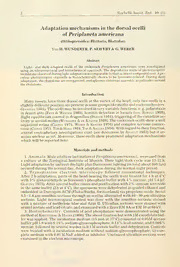
Adaption mechanisms in the dorsal ocelli of Periplaneta americana (Orthopteroidea: Blattaria, Blattidae) PDF
Preview Adaption mechanisms in the dorsal ocelli of Periplaneta americana (Orthopteroidea: Blattaria, Blattidae)
NachrBl.bayer.Ent. 40 (1) Adaptationmechanisnis in the dorsal ocelli ofPeriplaneta americana (Orthopteroidea:Blattaria.Blattidae) VonH.WUNDERER,P.SEIFERT&G.WEBER Abstract Light- and dark-adaptedocelliofthecockroach Periplaneta americana wereinvestigated usinganultrastructuralandhistochemicalapproach.Thedegradativerouteofphotoreceptive membraneobservedduringlightadaptationiscomparabletothatininsectCompoundeyes.Ape- culiarphotoreceptororganeileishistochemicallyshowntobelysosome-related. Duringdark adaptation,therhabdomsarereorganized;endoplasmiccisternaeassembleaspalisadesaround therhabdoms. Introduction ManyinsectshavethreedorsalocelliattheVertexofthehead;onlytwoocelliina slightlydifferentpositionarepresentinsomegroupslikemothsandcockroaches(rev. Goodman1981).Theocellimaybeinvolvedinveryvariablefunctions,e.g.polarotaxis indesertants(Fent&Wehner 1985),horizondetectioninlocusts(rev.Rowell1988), flightequilibriumcontrolindragonflies(Stange1981),triggeringofthecircadianac- tivityinarctiidmoths(Wunderer&deKrämer1989).Thecockroachocellishowawell organizedretina (Cooter 1975, Weber &Renner 1976) andcomplexnervousconnec- tions(Cooter1975,Toh&Hara1984,Toh&Sagara1984).Withregardtotheirfunction, several contradictoryinvestigationsexist(seediscussionbyRivault 1983)butitre- mainsunclearasyet.Moreover,theseocellishowprominentadaptationmechanisms whichwillbereportedhere. Materialsandmethods 1.Animals.MaleadultsorlastmsiarsoiPeriplanetaamericana'L.wereusedfrom a culture attheZoologicalInstituteofMunich. Theirlight/dark cyclewas 12:12h. Lightadaptationbyindirectdaylightplusfluorescentlighting(intotalabout800lux) occuredduringthenormalday,darkadaptationduringthenormalnightperiod. 2. Transmission electron microscopy followed conventional techniques. After2hadaptation,partsoftheheadbearingtheocelliwerefixatedfor4hat4°C with5%glutaraldehydeinSörensen'sphosphatebufferwith4%sucrose,pH7.4(cf. Glauert1975).Afterseveralbufferrinsesandpostfixationwith2%osmiumtetroxide inthesamebuffer(2hat4°C),thespecimensweredehydratedingradedethanoland embeddedinDurcupanACM(Fluka/Buchs,Switzerland)viapropyleneoxide.Serial 0.5-1.0ixmsemithinsectionsthroughanocellusalternatedwith60-90/umultrathin sections. Light microscopical control was done with the semithin sections stained wuriatnhyalamciexttautreeanofdmleeatdhycilternatee,blaunedaenxdamAiznuerdIwI.itUhltaraZteihsisnEseMct9iAonosrwEerMe1staatin6e0dkwVi.th 3. Histochemistry. ContentsofacidPhosphataseweredemonstratedusingthe methodofKreutzberg&Hager(1966).TheabovefixationbutwithIMcacodylatebuf- ferwasapplied.Theincubationmedium(15minat37°C)consistedof0.05Macetate bufferpH5.0with0.19%sodium-glycerophosphate,0.13%leadnitrate,and0.006% sucrose,followedbyseveralwashesin0.1Macetatebufferanddehydration.Controls weretreatedwithi)incubationmediumwithoutsodium-glycerophosphate;ii)com- pletemediumwithO.OIMNaFaddedasInhibitor.Unstainedultrathinsectionswere examinedintheelectronmicroscope. Nachi-Bl.bayer.Ent.40 (1) ResultsandDiscussion 1. Photoreceptors after light adaptation. Thestructuralfeaturesofthelight-adaptedocellushavebeendescribedingeneral byCooTER(1975)andWeber&Renner(1976).Therhabdomconfigurations(Figs. 1,4) arebuiltbyafusionof2-6rhabdomeresfromneighbouringphotoreceptorcells.Adis- stinctborderUnebetweentheSinglerhabdomeresistypicallyvisibleinsectionedpro- filesoflight-adaptedrhabdoms(Figs. 1,2).Thus,therhabdomerescomprisemicro- villiofequallength(approx. 1 /xm).Attherhabdomericborders(wherethemicrovilli originale), coatedpitsandmembranewhorlsareadhering.Thesubrhabdomericre- gionofthelight-adaptedphotoreceptorcellsexhibitssacculiofthesmoothendoplas- micreticuluminarandomdistribution(Fig.2).Additionalorganellescanbeobserved inthisregion:numerousGolgiStacks,differenttypesofdensebodies,lipiddroplets (Fig.3), andmultitubularbodies(Figs.2,3).Themultitubularbodieshavebeende- scribed by Weber & Renner (1976) as peculiarorganelles of thephotoreceptorcells withinthePeriplanetaocellus.Theyareonlypresentduringlightadaptation. Theseorganellescanbefurthercharacterizedbyahistochemicaltestforacidphos- phatases. Incubation of the ocellar retina with sodium glycerophosphate (see Methods)revealspositive, fine-granularleadprecipitatesonlywithinmultitubular (Fig. 3)anddensebodies.Precipitatesareneverfoundinlipiddropletsnearby(Fig. 3), orinanyothercompartment; theyarecompletelyabsentincontrols.Hence,multi- tubularanddensebodiesintheocellarphotoreceptorscanbeclassifiedaslysosome- relatedbodies(cf.Hafneretal.1980;rev.Blest1988). 2. Photoreceptors after dark adaptation. Several profound changes of the photoreceptor cell structure occurduring dark adaptation. Incontrasttothelight-adaptedrhabdoms,theclearmiddleborderline betweenadjacentrhabdomeresdisappears(Fig.4).Partsoftherhabdomeresinterdi- gitate(Fig. 5);now,itisnolongerpossibletodefinitelyascribethemtotherespective photoreceptorcells.Anumberofmicrovilliwithlenghtsofupto2.5/Limreachoverthe wholewidthofsuchrhabdomprofiles (Fig. 5). SeveralmicrovillarrowsshowaU- shapedappearanceastheybecomecross-connectedattherhabdomborderbymem- branelayers(Fig.5).Thisfeatureremindsof"membraneloops"inthedevelopmentof thisocellus(Toh&Yokohari1988),indark-adaptedocelliofwasps(Pabst&Kral1989) andofarctiidmoths(Grunewald&Wunderer1990). Afterdark adaptation, voluminous perirhabdomeral palisades areobvious along theentirerhabdomlength(Fig.4).Similarpalisadeshavealsobeendescribedindark- adaptedocelliofSc/iistocercagregraria(Goodman1970,1981).Simultaneously,smaller vesiclesandsacculiofthesmoothendoplasmicreticulumhavedisappearedfromthe receptorcellcytoplasminthisState.Itmaybeconcluded,therefore,thatthepalisades havebeenformedbyanaggregationandfusionofvesicularprofilesneartherhabdom border.Otherorganellesdescribedaboveforthelight-adaptedstatearelessfrequent orcompletelyabsent,inparticularthemultitubularbodies. ItfollowsthatobviousstructuraldifferencesoftheocelliinPeriplanetaamericana arecorrelatedwithlightanddarkadaptation.Atthesametime,thesedifferencesgive anindicationofthepathwaysformembraneturnover.Thelight-adaptedphotorecep- torcellsarecharacterizedbycontainingcertaintypesofdegradativeorganelles.The obsei"vedpinocytoticeventsandvesiclescanbeassumedtomedialetheincorporation ofmicrovillarmembranesintothereceptorcell,eventswhicharewellknowninother ivensviecrutleabrrabtoedipehsotaorreefcoerpmtoerdsf(orlelvos.wiWnhgiptieneotcyalt.os1i9s80(,1.Bcl.)eswthi1c98h8)a.reInsetlhdesoemcmastehse,omcuelütai-r photoreceptors of P.americana. Here, the frequent multitubularbodies mayserve thisfunction;thisissuggestedbytheirenzymecontent.Thetubuliwithinthesebodies arestructurallycomparablewiththerhabdomericmicrovilli(Fig. 3).Therefore,these bodiescouldbedirectlyformedbyaphagocytoticuptakeofrhabdomericpieces,an alternativeto themostlydescribedformationbyassembliesofpinocytoticvesicles NachrBl.bayer.Ent.40 (1) NachrBl.bayer.Ent.40 (1) (compareBlest1980).Thefurtherwayofdegradingincorporatedmembranesusually leadstodensebodies,andfinallytolipiddroplets(rev.Blest1988).Boththeseorgan- ellesarepresentinthelight-adaptedocellarphotoreceptorsofP.americana. Theformationofperirhabdomeralpalisadesduringdarkadaptationistypicalfor photoreceptorsintheocelliofP.americana,initsCompoundeyes(Butler1973),and inthoseofseveralotherinsects(rev.Goldsmith&Bernard1974).Itisdiscussedasan opticalconsequenceofsuchpalisadesneartherhabdomthattherefractiveindexbe- tween rhabdomeric microvilli and receptor cytoplasm becomes modified (see the abovereview).Thisresultsinatotalreflectionoflightattherhabdomborder,hence abetterguidingoflightwithinthedark-adaptedrhabdoms.Besidethisfunction,the ampleSystemofcisternaeformedbysuchpalisadescouldserveasaneffectiveand localcalciumsinkwhichwouldmodifythesensitivityofthereceptorcells(rev.Walz &Baumann1989). Inconclusion, ourexaminationhasshownthattheocellusofthecockroachPeri- planeta americana undergoes adaptational changes in the light and dark which involveaconsiderableturnoverofphotoreceptivemembranes. Zusammenfassung Hell-unddunkeiadaptierteOcellenderSchabePeriplanetaamericanawurdenul- trastrukturellundhistochemischuntersucht.BeiHelladaptationkanneinAbbaufo- torezeptiverMembranenübermehrereAbbaustufenfestgestelltwerden,wieervon Komplexaugen bekannt ist. Ein spezielles Degradations-Organell wird histoche- mischnachgewiesen.BeiDunkeladaptationkommteszueinerRhabdom-Umbildung undzurEntstehungvonrhabdomnahenPalisaden. Referenees Blest, A.D. 1980; Photoreceptor membrane turnoverin arthropods: comparativestudies of bofreCoanksdtoawnntpLriogchest.osensVainsduatlhePirrociemspsleisc.at-ionPsl.eInnuWmiPlrleisasm,sN,eT.wPY.o&rkB,a2k1e7r,-2B4.5N..:TheEffects - — 1988:TheturnoverofphototransductivemembraneinCompoundeyesandocelli.In:Evans, P.D.&WiGGLESWORTH,V.B.:AdvancesinInsectPhysiologyVol.20. -AcademicPress, London,1—53. Butler-,JR..C1o9m73p.:TPhheysainoal.to8m3"y2o3f9t-h2e6C2o.mpoundeyeofPeriplanetaamericanaL.2.Finestructure. Cooter,R.J.1975:OcellusandocellarnervesofPeriplanetaamericanaL.(Orthoptera:Dictyo- ptera).-Int.J.InsectMorphol.&Embryol.4,273-288. Fent,K.&Wehner,R.1985:Ocelli:acelestialcompassinthedesertantCataglyphis.-Science 228,192-194. Glauert,A.M.1975:Fixation,dehydrationandembeddingofbiologicalspecimens.In:Practical MethodsinElectronMicroscopyVol.3/1.-North-Holland,Amsterdam. GoLDSMiTH,T.H.&Bernakd,G.D.1974:Thevisualsystemofinsects.In:Rockstein,M.:ThePhy- siologyotInsectaII.-AcademicPress,London,165-272. Goodman,L.J.1970:Thestructureandfunctionoftheinsectdorsalocellus.-Adv.InsectPhy- siol.7,97-195. OcellarretinaotPeriplanetaamericana,left:inlightadaptation,right:indarkadaptation. Fig.1: Rhabdomconfigurations(RH)areformedbyseveralneighbourmgphotoreceptorcells with nuclei (N). Middle borderlinebetween contributing rhabdomeres indicated by arrows. Scale:5/um.Fig.2:Multitubularbody(MTB)neighbouring(electron-lucent)sacculiofendoplas- micreticulumandseveralelectron-denseprotiles.Rhabdom(RH)withdistinctmiddleborder- lsipnhea.tSacsaelew:it1hßinm.muFlitg.it3u:buEllaecrtbroond-yde(nMsTeB,)doetn-clliokseinpgrelciippiidtadtreosplientdi(cLa)t.iNngotaectsiivmiitlyaroiftaycoifdMPhToB- Contentswithmicrovilliofrhabdom(RH)nearby.(x16.800). Figs.4,5: RH: dark-adaptedrhabdoms,N:photoreceptornuclei. Subrhabdomericpalisades indicatedbysmallarrows.5showsaggi-egationotsmallerperirhabdomeralcisternae(arrows), Insetin4showslargepalisades.Noteabsenceofmiddleborderlineswithinrhabdoms(RH)(only partiallyin5).Arrowheadsin5indicateU-shapedmicrovilliandmembraneloops.Scalebars: 5/u,min4,1/um5. NachrBl.bayer.Ent.40 (1) - - 1981: Organisation and physiolog>' oftheinsect dorsalocellarSystem. In: Autrum, H.: HandbookofSensoryPhysiologyVol.VII/6C.-Springer,Berlin,201-286. Grünewald,B.&Wunderer,H.1990;Theocelliofarctiidmoths:structureofthelight-anddark- adaptedretina.In:ELSNER,N.&RoTH,G.:Proc. 18thGöttingenNeurobiol.Conf.-Thieme, Stuttgart,204. Hafner,G.S.,Hammond-Soltis,G.&Tokarski,T. 1980:Diurnalchangesoflysosome-related bodiesinthecrayfishphotoreceptorcells.-CellTissueRes.206,319-332. Kreutzberg,G.W.&Hager,H.1966:ElectronmicroscopicaldemonstrationofacidPhosphatase Pabst,acMt.ivAi.ty&inKrtahel,ceKn.tr1a9l8n9:erEvfofuesctSsysoftegmr.ee-nHainsdtoUcVhelmiigeht6,an2d54d-a2r5k9n.essontheultrastructure ofocellarphotoreceptorsinthewaspParavespulagermanica.-Z.mikrosk.anat.Forsch. 103,459-475. Rivault,C.1983:Roleofphotoreceptorsinthesynchronizationofthecircadianlocomotoracti- vityrhythmswiththeLDcycleincockroaches{Periplanetaamericana).-J.interdiscipl. CycleRes.14,21-31. RowELL,C.H.F.1988:Mechanismsofflightsteeringinlocusts.-Experientia44,389-395. Stange,G.1981:Theocellarcomponentofflightequilibriumcontrolindragonflies.-J Comp. Physiol.141,335-347. ToH,Y.&Sagara,H.1984:DorsalocellarSystemoftheAmericancockroach.1.Structureofthe ocellusandocellarnerve.-J.Ultrastruct.Res.86,119-134. ToH,Y.&Hara,S. 1984: DorsalocellarSystemoftheAmericancockroach.2.Structureofthe ocellartract.-J.Ultrastruct.Res.86,135-148. ToH,Y.&Yokohari,f.1988:PostembryonicdevelopmentofthedorsalocellusoftheAmerican cockroach.-J.Comp.Neurol.269,157-167. Walz,lBo.gi&caBlauamnadnnf,unOc.ti1o9n8a9l:Ccahalrcaicutme-rsiezqauteiosnt.er-ingPrcoelglr.orgHainsetlolecsh:emi.nsiCtyutloocchaelimz.atViooln.,m2o0r/pNhoo2-, G.Fischer,Stuttgart. Weber,G.&Renner,M.1976:Theocellusofthecockroach,Periplanetaamericana(Blattariae). Receptoryarea.-CellTissueRes.168,209-222. White,R.H.,Gifford,D.&Michaud,N.A.1980:Turnoverofphotoreceptormembraneinthelar- valmosquitoocellus:rhabdomericcoatedvesiclesandorganellesofthevacuolarSystem. In: Williams,T.P.&Baker,B.N.:TheEffectsofConstantLightonVisualProcesses. - PlenumPress,NewYork,271-296. Wunderer,H.&deKramer.J.J.1989:Dorsalocelliandlight-induceddiurnalactivitypattems inthearctiidmothCreatonotostransiens.-J.InsectPhysiol.35,87-95. AnschriftderAutoren: HansjörgWunderer,Zoolog.Institut/Biol.I, Universitätsstraße31,D-8400Regensburg,F.R.G. PeterSeifert,Zoolog.Institut,Luisenstraße14,D-8000München2,F.R.G. GerhardWeber,PlaneggerStraße24A,D-8000München,F.R.G. Wie sehenInsektenpolarisiertes Licht? (Diptera,Syrphidae,Tabanidae) VonFranziskaPILSTL,AndreasLANGE,PeterSEIFERTundUlrichSMOLA Abstract ForthreedipteranspecieshighlyspecializedvisualcellsinthedorsalrimareaoftheCompound eyearedescribed.Withintheseommatidiatheeightretinulacellsaremorphologicallydifferent fromthoseofnormalommatidia.TheretinulacellsRl-6havereducedrhabdomeresandcellso- mata,therhabdomeresofthecentralcellsR7andR8areenlarged.Thesetwocellsformshort rhabdomeralSegments,whicharealignedoneafteranothersoresemblingtherhabdomsfoundin some Crustaceans. Judging from their morphology these highly specialized ommatidia are extremelysensitiveforpolarizedskylight. ImGegensatzzuunsMenschenbesitzenInsektenverschiedenerOrdnungendiebe- merkenswerteFähigkeit,linearpolarisiertesLichtwahrnehmenzukönnen.
